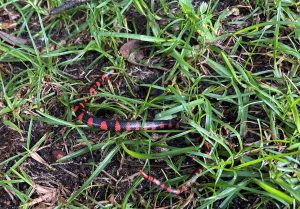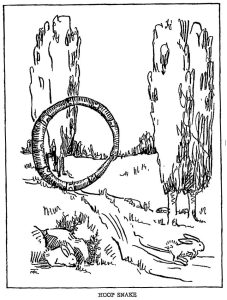
People have a lot of strong feelings about snakes. Whether it be fear, alarm, hatred, or wonder, it’s rare someone doesn’t react at all to seeing a snake in front of them. I will say, though, that when one of our volunteers sent a photo of a snake he’d come across in his yard, my very first thought was, simply, “Wow!” This was no ordinary snake—it was truly beautiful. Shiny black with deep red markings, its scarlet body resembled jewelry more than reptilian coloration. Our resident snake pro, Rick, identified it quickly as a mudsnake, but its drab name is a poor fit for its attractiveness.

As an adult, this species can grow to be around 4-5’ long. The red, or sometimes pink, body has alternating black bands that remind me of piano keys. Mudsnakes are nonvenomous and found throughout Florida except for the Keys. In our region of the Panhandle, the Eastern mudsnake (Farancia abacura) may interbreed with the Western mudsnake (Farancia abacura reinwardtii). The Western has a handful fewer red/pink bars on its body but otherwise nearly identical.

The snakes are considered aquatic species, preferring wet habitats like marshes, swamps, ditches, and open-water rivers and lakes. They can live in both fresh and brackish water. This one was reported from a Perdido Key neighborhood, which is an expected location. Appropriately for their habitat, they feed on frogs, fish, and salamanders. When reproducing, females will stay with their eggs (average 30) until they hatch, which may be from late summer to October.
Mudsnakes are not aggressive and will usually leave in the presence of humans. This likely accounts for their rare sightings. The snakes may attempt a fake strike, but even during this behavior their mouths will be closed. Members of the species will sometimes rest with their bodies in a circular shape and also have a spiny scale at the base of their tail. These two factors likely gave rise to the legend of the “hoop snake,” which has been told in the deep South since early colonial days. This wild tale states that the snake will grab its own tail by the mouth and roll down a hill like a wheel, aiming at a victim. Once upon its prey, the snake unfurls and slings itself like a spear, tail-first with that “spine” into a victim. The myth states that the spiny section of their tail is so venomous that even a tree struck by a “hoop snake” will die. Floridians are known to come up with some crazy stories, but this one really cracks me up. According to lore, the best way to escape from a hoop snake is to run uphill, or behind a tree. Needless to say, the tale of the hoop snake is complete fiction.
 8
8
